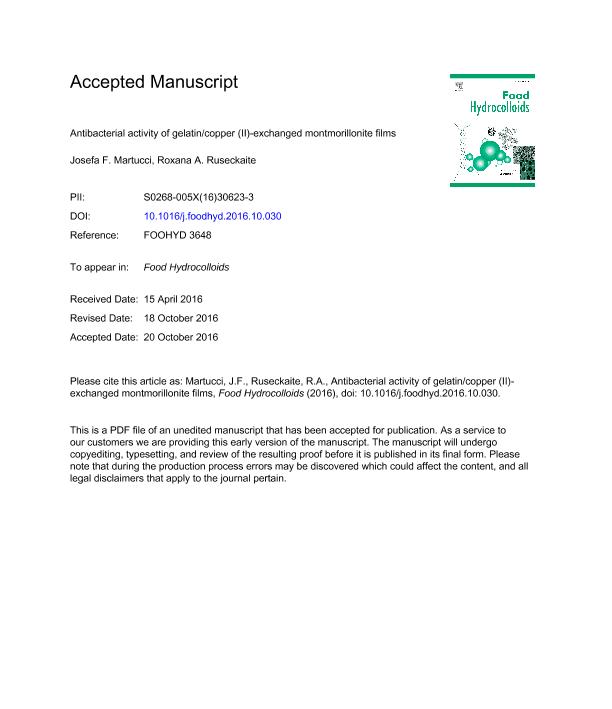Artículo
Antibacterial activity of gelatin/copper (II)-exchanged montmorillonite films
Fecha de publicación:
21/10/2016
Editorial:
Elsevier
Revista:
Food Hydrocolloids
ISSN:
0268-005X
Idioma:
Inglés
Tipo de recurso:
Artículo publicado
Clasificación temática:
Resumen
Cu (II) - exchanged montmorillonite (Cu2+MMt) was prepared, characterized and introduced into a bovine gelatin (Ge) matrix via a dissolution-intercalation method to get antibacterial nanocomposite films. The maximum amount of exchanged cation did not exceed the cation exchange capacity of the pristine montmorillonite (Na+MMt), as assessed by energy dispersive X-ray (EDX) spectroscopy. Cu2+MMt showed antibacterial activity in vitro against Escherichia coli O157:H7 (Gram-negative) and Listeria monocytogenes (Gram-positive) as revealed by the agar disc-diffusion assay. The dispersion of clays in Ge films was monitored by X-ray diffraction (XRD) and Scanning Electron Microscopy (SEM). Blending gelatin with 5% w/w of clay increased the tensile strength of the nanocomposite films in around 280% while the elongation at break and the water vapor permeability decreased in about 42 and 30%, respectively, regardless of the cation in clay. The Ge/Cu2+MMt film exhibited antibacterial effectiveness against both pathogens tested under the same conditions, demonstrating a stronger effect on L. monocytogenes than on E. coli O157:H7, since the cell wall of the latter differs significantly and such difference could influence their vulnerability and response to the active films. Therefore, the incorporation of low clay levels as a vehicle for copper ions into gelatin matrix has demonstrated to be a good method for developing functional materials that can be potentially applied to the design of food contact items.
Archivos asociados
Licencia
Identificadores
Colecciones
Articulos(INTEMA)
Articulos de INST.DE INV.EN CIENCIA Y TECNOL.MATERIALES (I)
Articulos de INST.DE INV.EN CIENCIA Y TECNOL.MATERIALES (I)
Citación
Martucci, Josefa Fabiana; Ruseckaite, Roxana Alejandra; Antibacterial activity of gelatin/copper (II)-exchanged montmorillonite films; Elsevier; Food Hydrocolloids; 64; 21-10-2016; 70-77
Compartir
Altmétricas




